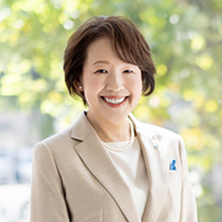Promotion of DE&I
As a pioneer of new markets at a time of fragmented individual tastes, the KING JIM Group continues its search for new business styles. We provide work environments that accommodate employees of differing backgrounds, diverse in gender, age, working styles, presence of disabilities, and other aspects. In the belief that incorporating the ideas of these employees will lead to responses to changes in the business environment and the company's growth, the KING JIM Group works to Promotion of DE&I.
Our company employs a wage system based on grades, evaluations, and groups into which individuals are categorized according to the roles and responsibilities they should undertake to contribute to the Company's performance, as stipulated in the personnel system regulations. Guided by the principle of equal pay for equal work, we do not create wage disparities based on employment status for the same work under this wage system.
Regular employees: Employees employed on a permanent basis
Non-regular employees: Employees including part-time employees and contract employees, excluding temporary dispatch employees
Wages: Includes base pay, overtime pay, and bonuses, excluding severance pay, commuting allowances, and other non-taxable items
Under this system, once a year, the KING JIM Group asks all employees (including temporary employees) to directly communicate and share their thoughts on any matters, including their future careers, current job status, workplace issues, and business policies, to top management. The content is shared only with the President and a number of executives and used for appropriate personnel allocation and work environment improvement.
We hold a monthly all-hands morning assembly which employees can attend both in-person and online. Following each assembly, we conduct a survey and make improvements based on employee feedback and requests.


Period of the plan : April 1, 2017 to March 31, 2026
2. Creation of a corporate culture for the enhancement of work-life balance
 Note: Unless noted otherwise, published data are aggregated for the June 2025 period (June 21, 2024, to June 20, 2025) or are figures as of June 20, 2025.
Note: Unless noted otherwise, published data are aggregated for the June 2025 period (June 21, 2024, to June 20, 2025) or are figures as of June 20, 2025.
The situation with employees(KING JIM non-consolidated)
Number of employees |
Men |
Women |
Total |
| Full-time employee |
226 |
140 |
366 |
| Contract employee |
4 |
3 |
7 |
| Employee rehired after reaching mandatory retirement age |
41 |
4 |
45 |
| Part-time employee |
1 |
28 |
29 |
Number of new hires |
Men |
Women |
Total |
| Full-time employee | 8 |
9 |
17 |
| Part-time employee | 0 |
0 |
0 |
Age / Years of service |
Men |
Women |
Total |
| Average age of employees | 43.9 |
36.9 |
41.3 |
| Average years of service of employees | 19.7 |
13.2 |
17.2 |
Wages
Gender pay gap (ratio of women’s wages to men’s wages)
Type of employees |
unit |
FY ended June 2025 |
| All employees | % |
70.0 |
| Regular employees | % |
71.6 |
| Non-regular employees | % |
68.5 |
Non-regular employees: Employees including part-time employees and contract employees, excluding temporary dispatch employees
Wages: Includes base pay, overtime pay, and bonuses, excluding severance pay, commuting allowances, and other non-taxable items
Efforts to utilize employees' opinions in management
Self-reports
Company-wide morning assembly
Implementation of DE&I training

〈Next leader meeting〉
In July 2024, we conducted a training program for next-generation leadership candidates, focusing on leadership and career development in the workplace from a DE&I perspective.
〈Expert meeting〉
We conducted training in November 2024 to raise awareness of unconscious biases and deepen understanding of DE&I.
〈e-learning〉
We regularly conduct training for all employees through e-learning to promote understanding of DE&I and unconscious biases.
Promotion of active participation by women

As of June 20, 2025, the percentage of female managers in the Company was 13.8%. We have set a goal of increasing this percentage to 30% by 2030.
We have appointed five female Directors and one female Corporate Auditor to the board, with 71.4% of our independent external board members being women.
Plan of action for general employers based on the Act on Promotion of Women's Participation and Advancement in the Workplace (KING JIM non-consolidated)
Issues for our Company : Length of service is lower for women than for men. We face a shortage of female managers and female candidates for managerial positions.
Target : We will raise the average length of service for female full-time employees from 13.8 years (as of March 2016) to 16.0 years by March 31, 2026.
The details of initiatives, and the implementation period:
1. Initiatives to reduce the number of female employees who resign from work due to marriage, childbirth, or childcare.
Implementation period |
Contents |
| from April 2016 | Distribution of Company informative email messages to employees taking maternity leave and childcare leave (once a month) |
| from March 2018 | Interviews before maternity leave and childcare leave, Interviews following maternity leave and childcare leave. |
| from March 2018 | Created and distributed a “life event handbook” that summarizes internal systems and procedures that can be used when an employee experiences life events. |
| from March 2018 | Created and distributed the “Iku-Boss Manual” to direct supervisors of departments that will welcome pregnant employees and employees returning to work after taking childbirth/childcare leave. |
| from April 2025 | Individual consultations on childcare preferences and provision of information. |
Implementation period |
Contents |
| from September 2017 | We have set a target for the number of days of paid leave that all employees should take. (In the term ending June 2024, our target is eight days of leave.) |
| from April 2018 | We have set Wednesday as a no-overtime day, and the last time employees could leave the office was established at 20:05. |
| from April 2018 | In cases of overtime over the above provisions due to unavoidable circumstances, an application for special approval for the overtime work and approval by the officer in charge is required. |
| from April 2018 | The supervisors of employees whose overtime exceeds 45 hours a month are given warnings. |
| from June 2023 | The introduction of spouse accompaniment transfersystem, spouse accompaniment leave system, job return system. |
| from April 2025 | Introduction of hourly annual paid leave. |
| from July 2025 | Implementation of summer leave selection system. |
Employment of persons with disabilities

We are actively working to employ people with disabilities. We have established a satellite office in Kawagoe City, Saitama Prefecture, and Yokohama City Kanagawa Prefecture, which provides full support for employees with disabilities.
As of June 2025, the employment rate of persons with disabilities is 2.96% (statutory employment rate of 2.5%).
- Environmental Policy
- Responding to Climate Change
- Eco-Friendly Products
- Collecting "TEPRA" PRO Tape Cartridges
- Environmental Conservation Activities
- Labor Health and Safety
- Promotion of DE&I
- Human Resource Development
- Work-Life Balance
- Human Rights
- Procurementt
- Product Safety
- Social contribution



 Environment
Environment Social
Social Governance
Governance